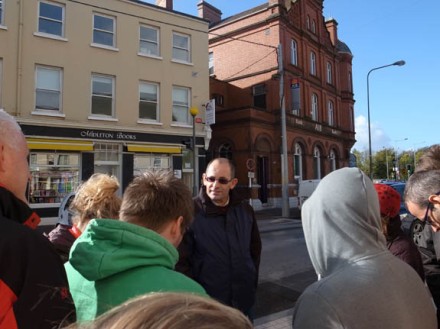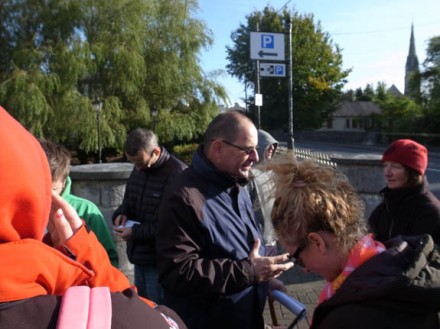Friday, 31st October marks the end of the bright half of the year – Samhradh or ‘summer.’ At sundown the dark half of the year begins – Geimhreadh or ‘winter, which will last until the 1st of May! (Don’t worry – we DO have the seasons of spring and autumn in Ireland, but these are really subdivisions of the two principal seasons.) We have already put our clocks back (last Sunday) and the sudden darkness in the late afternoon is still shocking, especially after the long, dry, warm and bright summer and autumn. And it’s worth noting the timing of the time change is a modern co-incidence derived from the British need to increase productivity in arms factories during the First World War.
And, note, I said that summer ends at sundown on 31st October. This is an ancient idea. To this day the church (Catholic/Orthodox/Anglican) still starts the sabbath (Sunday) at sundown on the previous day. This is usually marked by the First Vespers of Sunday which is sung at sundown on Saturday. The Second Vespers of Sunday marks the end of Sunday at sundown on Sunday – and the same structure is used for major feasts of the church. This tradition was inherited from the Jewish religion.
Curiously, the ancient Irish seem to have followed the same practice – beginning their four great feast days (Imbolc, Beltaine, Lughnasa, Samhain) at sundown on the previous day. So at sundown begins the feast of Samhain – the feast that marks the definitive and official end of summer and the completion of the harvest. Even the name reflects this – samhradh (summer) and samhain (summer’s end).
Ancient calendars attempted to reconcile the phases of the moon (months) with the annual cycle of the sun. Feast days could moved, depending on the moon. And Samhain was probably no exception – it probably didn’t always fall on 31st October/1st November. The fixing of the date came later, under the influence of Christianity.
In ancient times Samhain was a VERY sociable affair, probably lasting three days. It was a time of gathering and feasting but also marked the end of the season for making war and the end of the season for travelling – the warriors and merchants and other travellers returned home. Samhain seems also to have been a time for settling accounts – curiously the self-employed in Ireland have to make their tax returns to the Revenue Commissioners by close of business on 31st October – but, despite the horrors it brings, this is NOT a Halloween tradition! (Perhaps the Irish taxman has a morbid sense of humour.) It is worth noting that until the land reforms of the early twentieth century in Ireland, the 11th of November (Martinmas – the feast of St Martin of Tours) was a deadline for paying quarterly rents in Ireland. One wonders if this is a hangover from the celebration of Samhain. Settling accounts at Samhain made sense, since much social life would be lived indoors for several months until the weather became warmer and dryer again – it’s much easier to socialize indoors with people when everyone has settled their accounts with each other.
The sociability of Samhain was exacerbated by the presence of not only of family, friends and neighbours, creditors and debtors, but also of the ancestors and the denizens of the spirit world, both good and bad. On the first night of Samhain after sundown the veil dividing this world of man from the world of spirits was considered to have faded so as to permit the spirits and sidhe (fairies)to enter the world of man. This weakened veil also permitted the spirits to kidnap men and women and children and take them to the other world – a frightening prospect if you were kidnapped by someone who wanted to settle an old score with you! Hence the need to don a disguise (preferably of a frightening kind!).
This brings me to a modern Irish gripe. Many people in Ireland feel that the festival is too Americanized. Well, pumpkins were not known in Ireland in ancient times – so they have a point there. They also complain about children dressing up as Power Rangers, Batman, Iron Man, Mutant Ninja Turtles and what have you – but actually the kids have got it exactly right! The point of the disguise is to protect the wearer of the disguise, not necessarily to scare off the evil spirits.
Fire seems to have played a major part in the festivities of Samhain, as it did in Beltaine (now 1st of May). This, naturally made sense – fire kept you warm in the cold months of winter. But it also came to the fore in the making of spooky lanterns – the Jack O”Lantern story is suspect in my opinion since it is probably a relatively moderns story. But the use of lanterns to illuminate the darkness and reveal any hiding places for spirits on that night does make sense.
When Christianity came to Ireland, the clergy very sensibly tried to convert the people, their places of religious assembly AND certain traditions. Pope Gregory I (pontiff 590-604) is usually credited with advising missionaries to Christianize places, customs and feasts, so that the newly converted populace would find some familiar features in their new religion. In Ireland this led to the tradition of holy wells and adaptations in the calendar – the feast of Imbolc (1st February) became the feast of St Brigid of Kildare. Eventually, even Samhain succumbed to Christianity – the feast of All Saints (All Hallows) was gradually moved from April or May to 1st November (it was certainly being celebrated at this date by Charlemagne (crowned emperor in 800). With the addition of the Feast of All Souls (2nd November) the whole festival of Samhain had become a Christian celebration. Thus, Samhain became fixed as Halloween.
Even today in Ireland the dead are still commemorated with cemetery prayers throughout the month of November – the month of the dead. And the Mexican Day of the Dead has echos of this – although its origins are considered entirely different.
As youngsters in Midleton we had it lucky in late October. The trucks bringing sugar beet to the Mallow sugar beet factory often dropped beets from the top of their load as they turned a sharp bend on the road near the house. We gathered these stray beets and made our lanterns out of them, many a decent chisel being ruined in the process. Before sugar beet was used, the lanterns were made out of turnips – which can give a very spooky appearance. We went ‘a haunting’ (‘trick or treat’ is an Americanism, it even sounds like a holdup!) in the neighbourhood, but the suburban lights could ruin the effect. Much better was a trip out the country – just three miles – to my cousins in Ballintotis, where there was a old ruined castle and very little light. Visiting Ballintotis Castle on Samhain was eerie fun! I feel that the whole tradition works better in the countryside than in towns – too many street lights ruin the atmosphere. And remember, Samhain was also the great feast celebrating the end of the harvest – many of the traditions are linked to food, a feature of harvest festivals. Daniel Maclise’s 1833 painting ‘Snap-Apple Night’ is the best depiction of the older traditions celebrated on Halloween (in Blarney apparently), but a word to the wise, it has probably been sanitized to satisfy increasingly uptight English sensibilities. Most of the activity in the painting involves activities to predict the future – especially potential marriages (hence the group of young ladies on the lower left foreground).
One other gripe one hears is that Halloween is ‘unchristian’ – that’s a very puritanical view showing up the prejudice of the person who holds such a view – remember it was the devoutly Christian puritans of Salem village in Massachusetts wholaunched an orgy of judicial murder in 1692-1693. The Salem Witch Trials were a true Halloween horror. So, have no truck with sour prejudice this Halloween – .go and celebrate the bounty of nature and have fun. And light a lantern to scare any sourpusses off – they are the real evil spirits of Samhain/Halloween.
Daniel Maclise’s ‘Snap Apple Night‘ link:
http://en.wikipedia.org/wiki/Halloween#mediaviewer/File:Snap-Apple_Night_globalphilosophy.PNG
Traditional Irish mask in the Museum of Country Life, Castlebar:
http://en.wikipedia.org/wiki/Halloween#mediaviewer/File:Traditional-irish-halloween-mask.jpg
Very spooky traditional lantern made from a turnip (Museum of Country Life, Castlebar):








